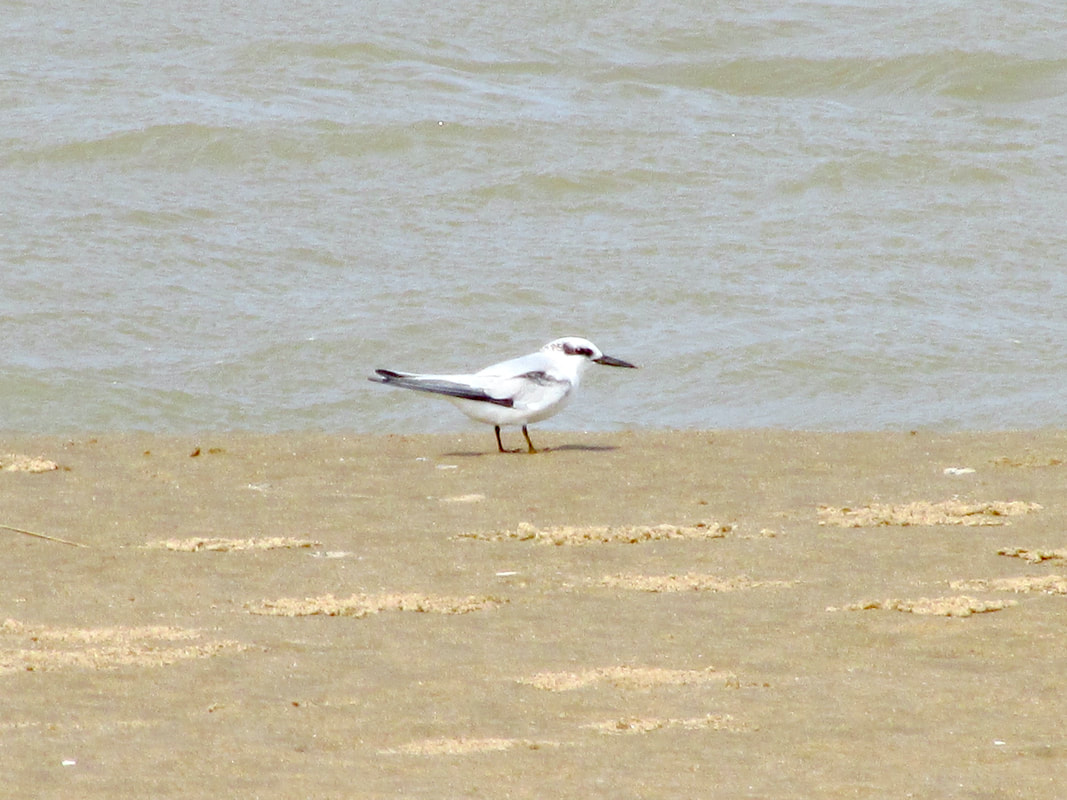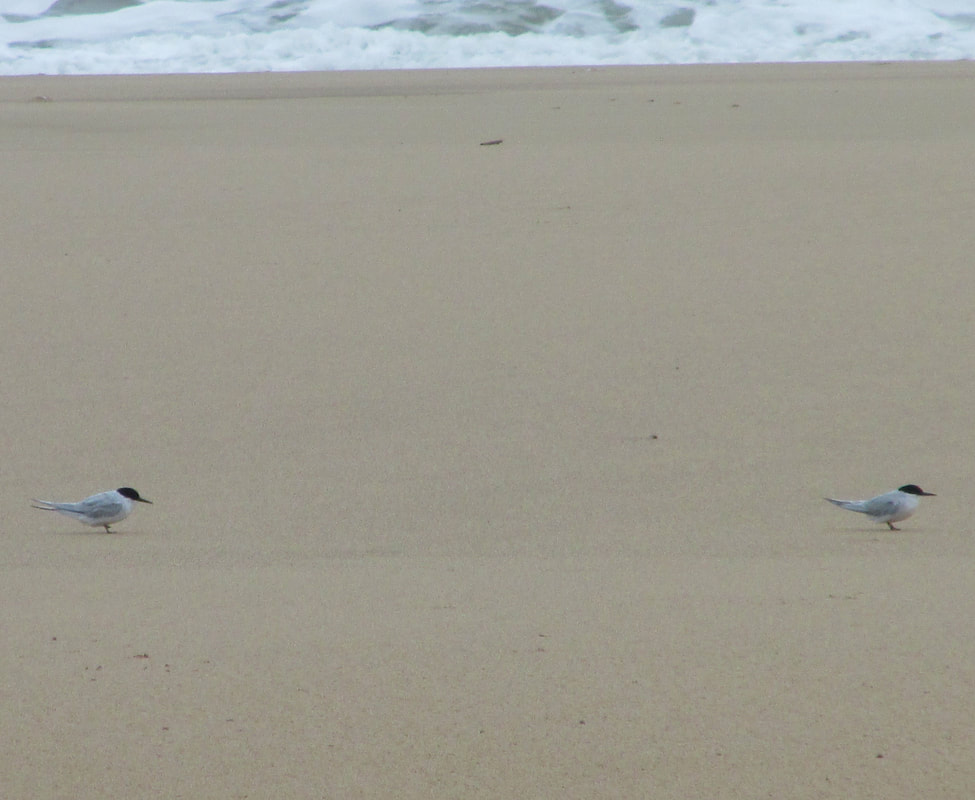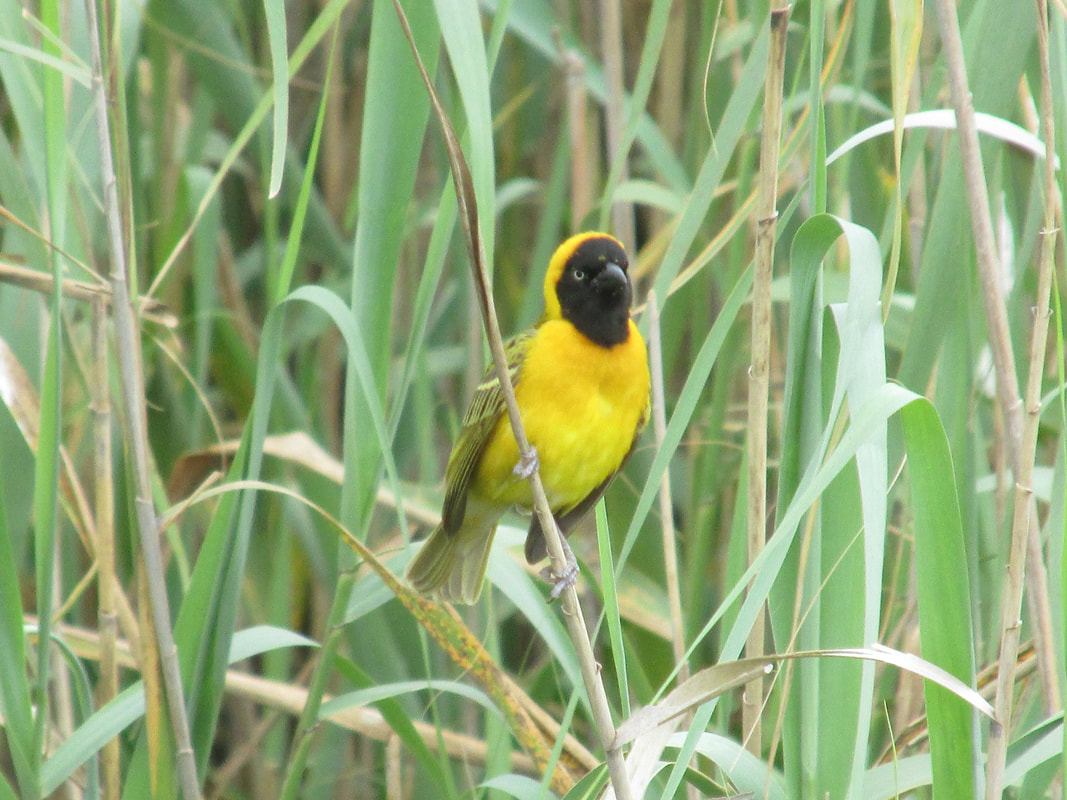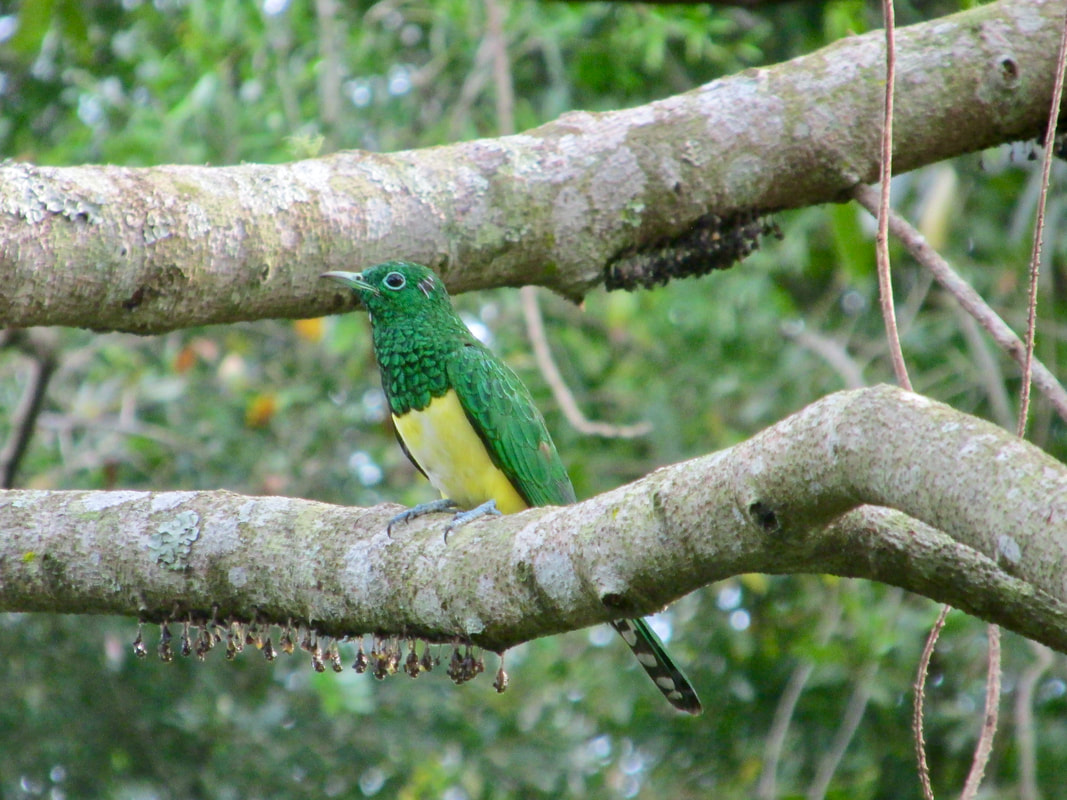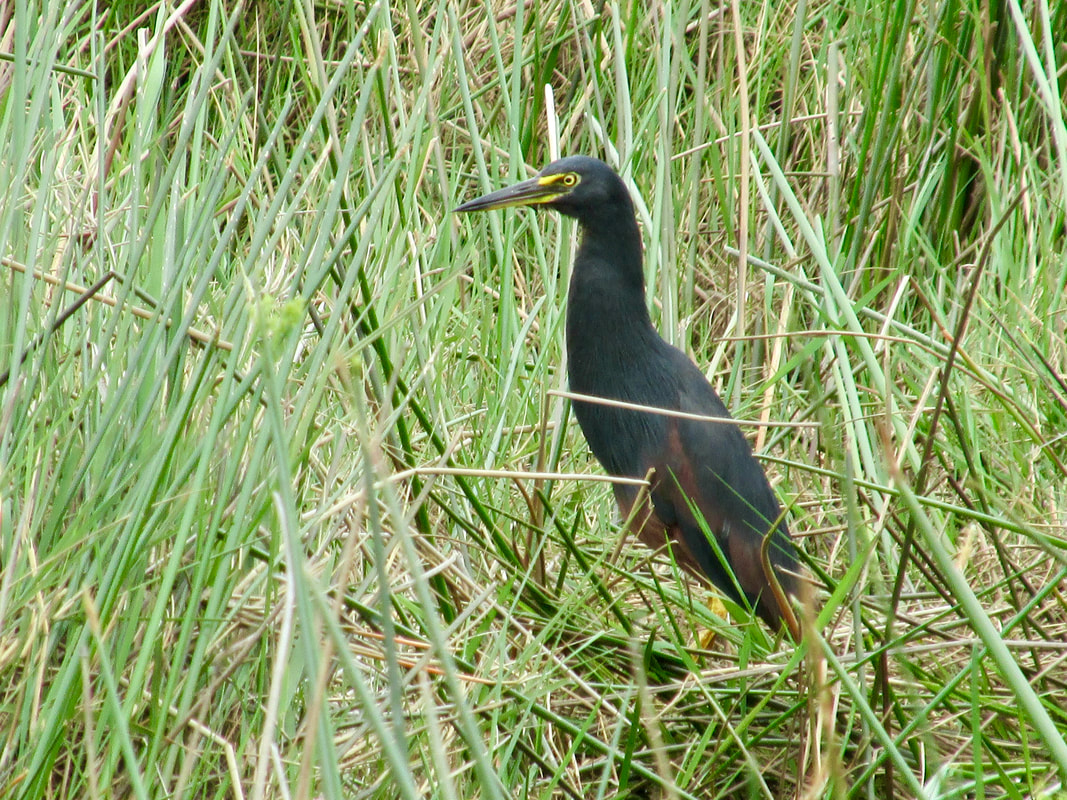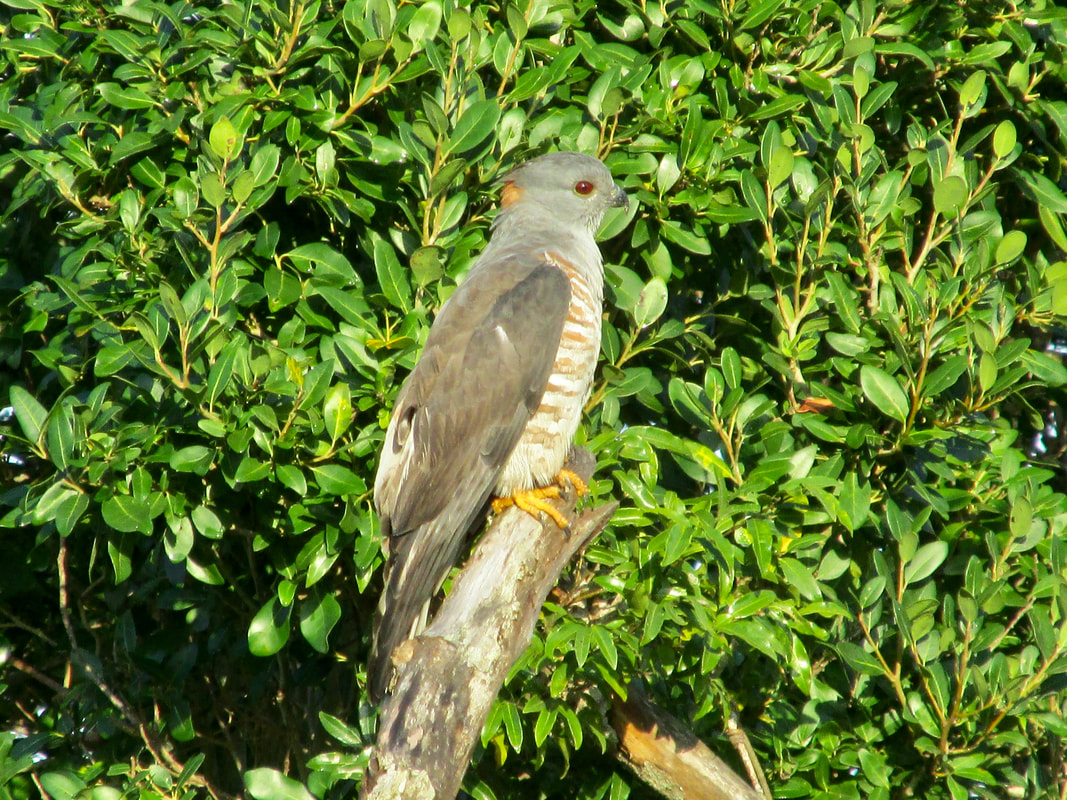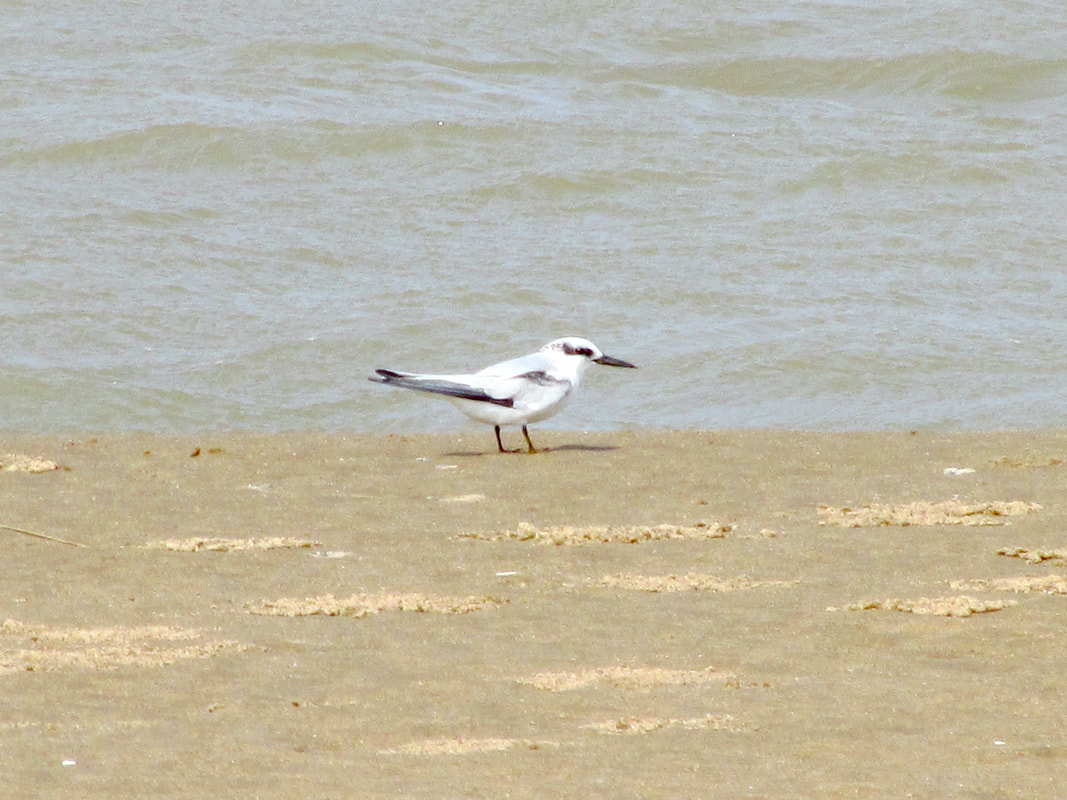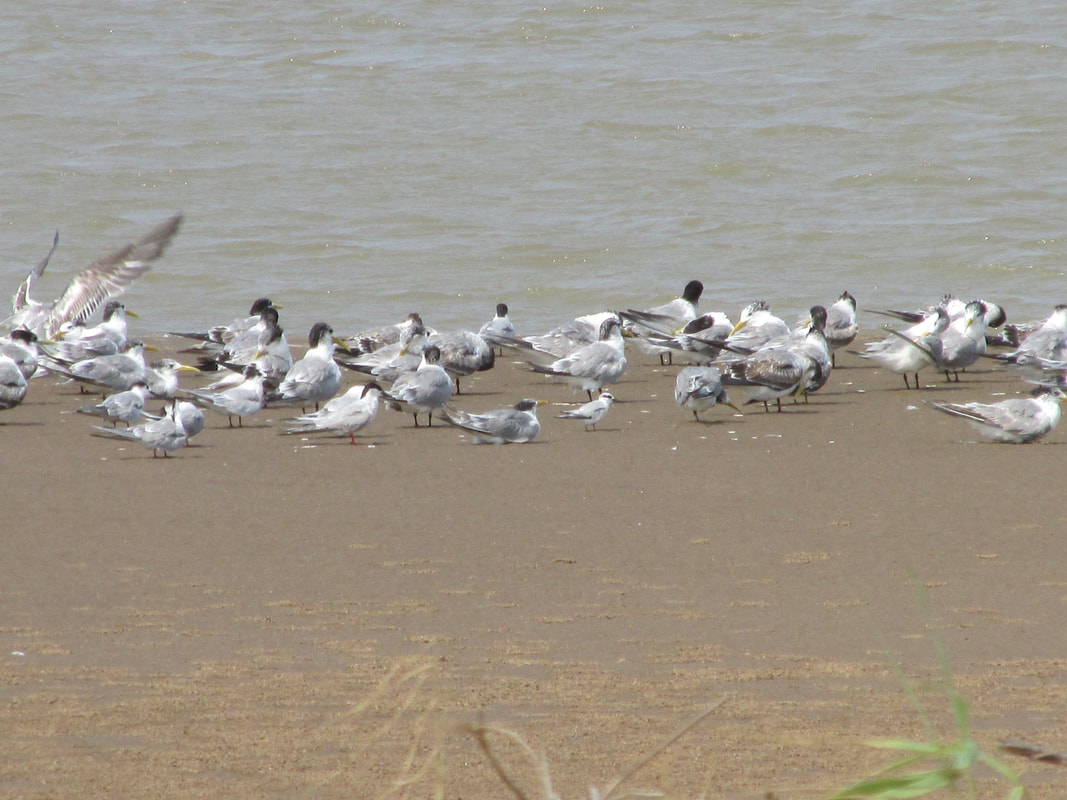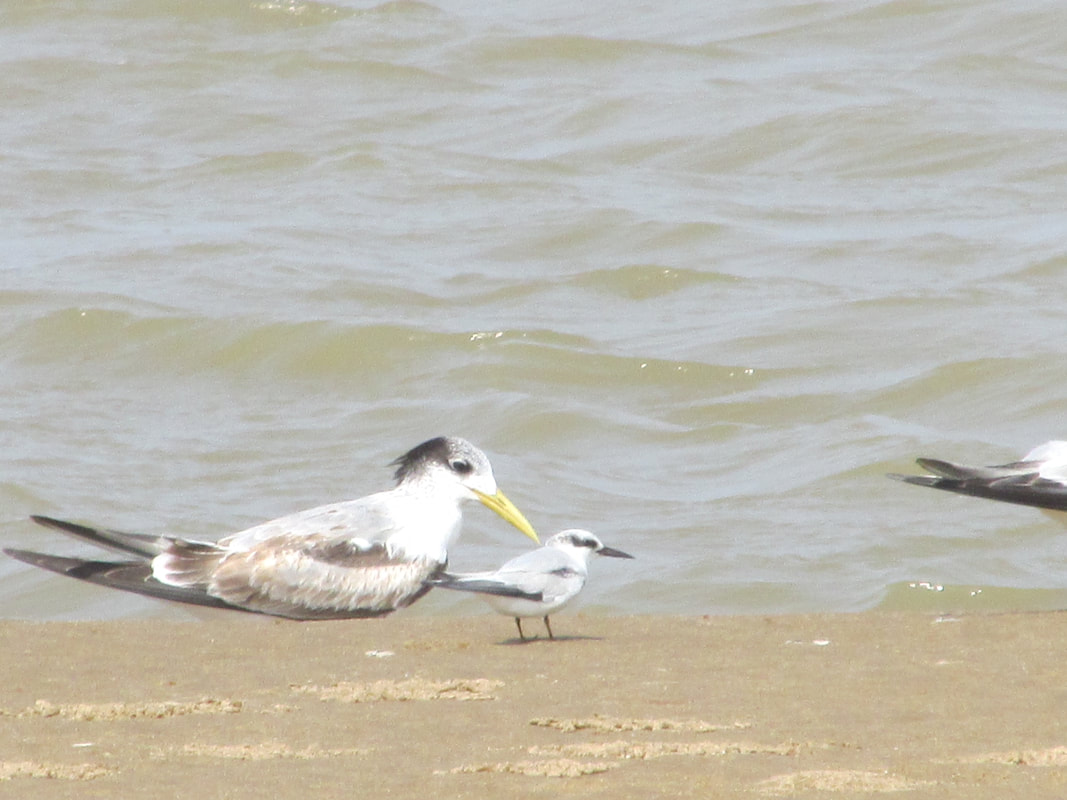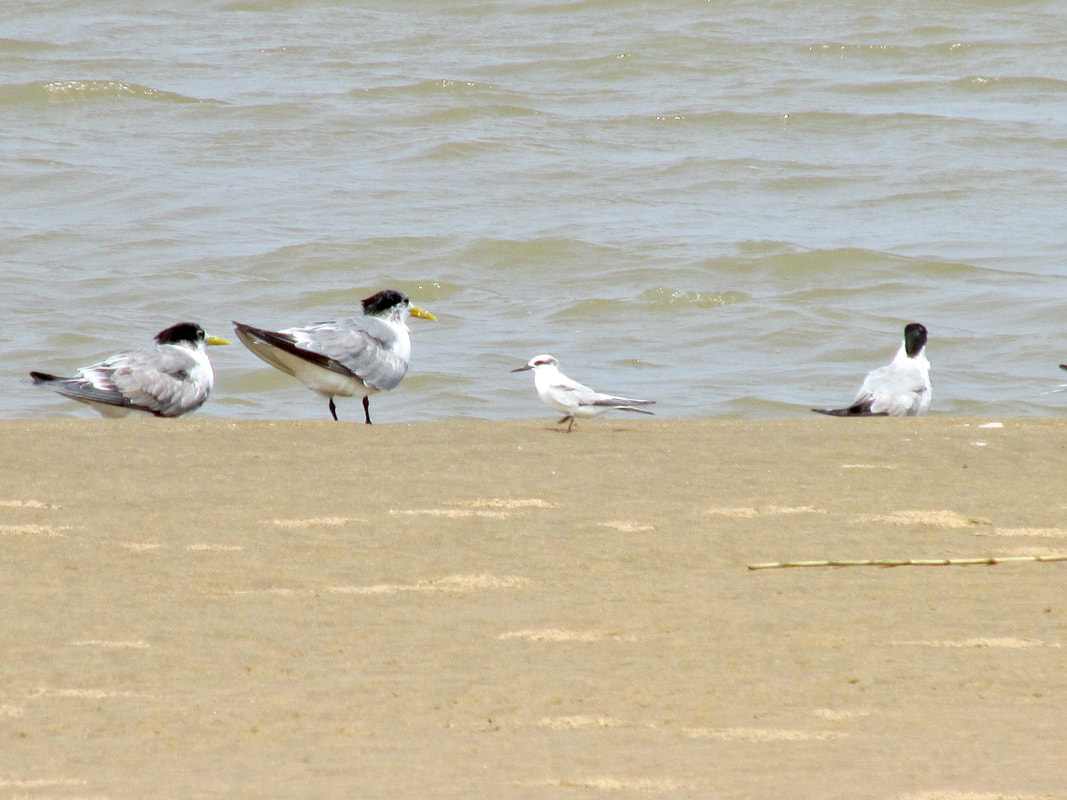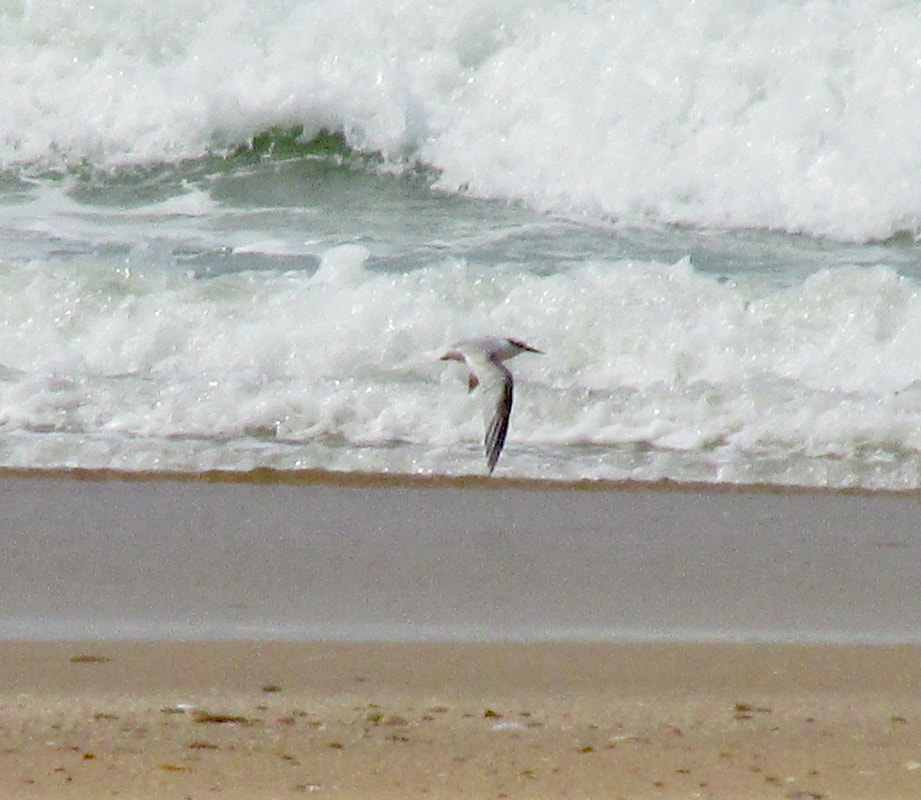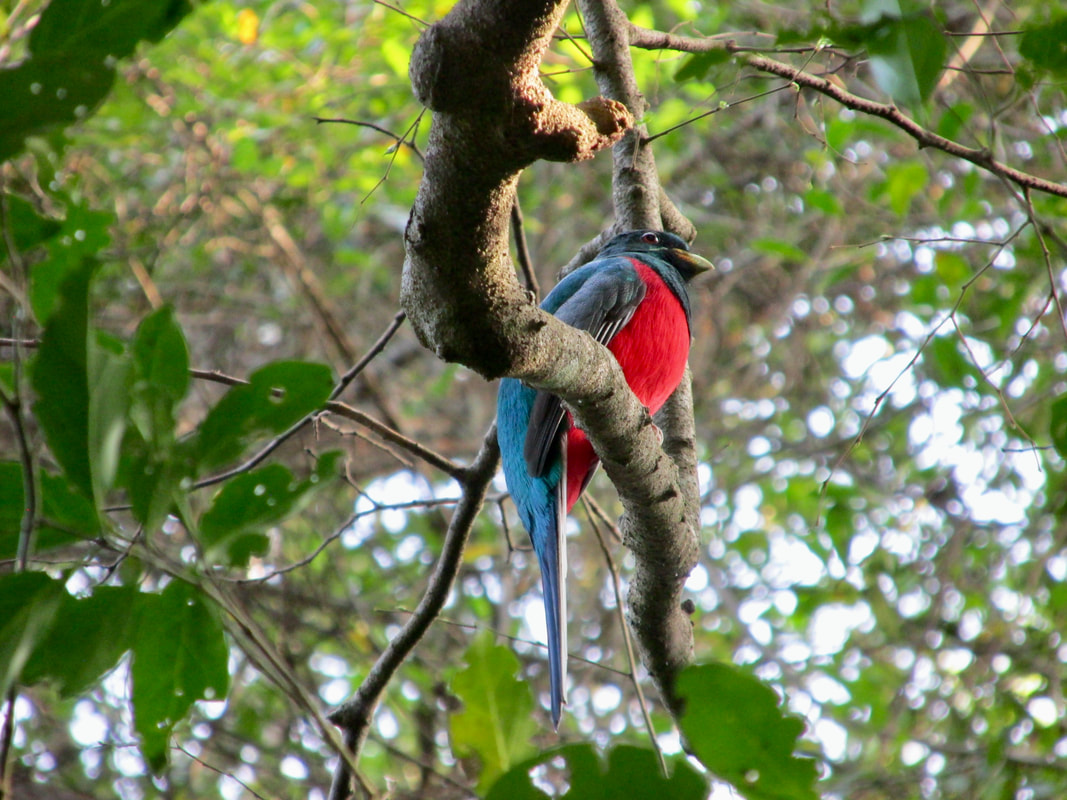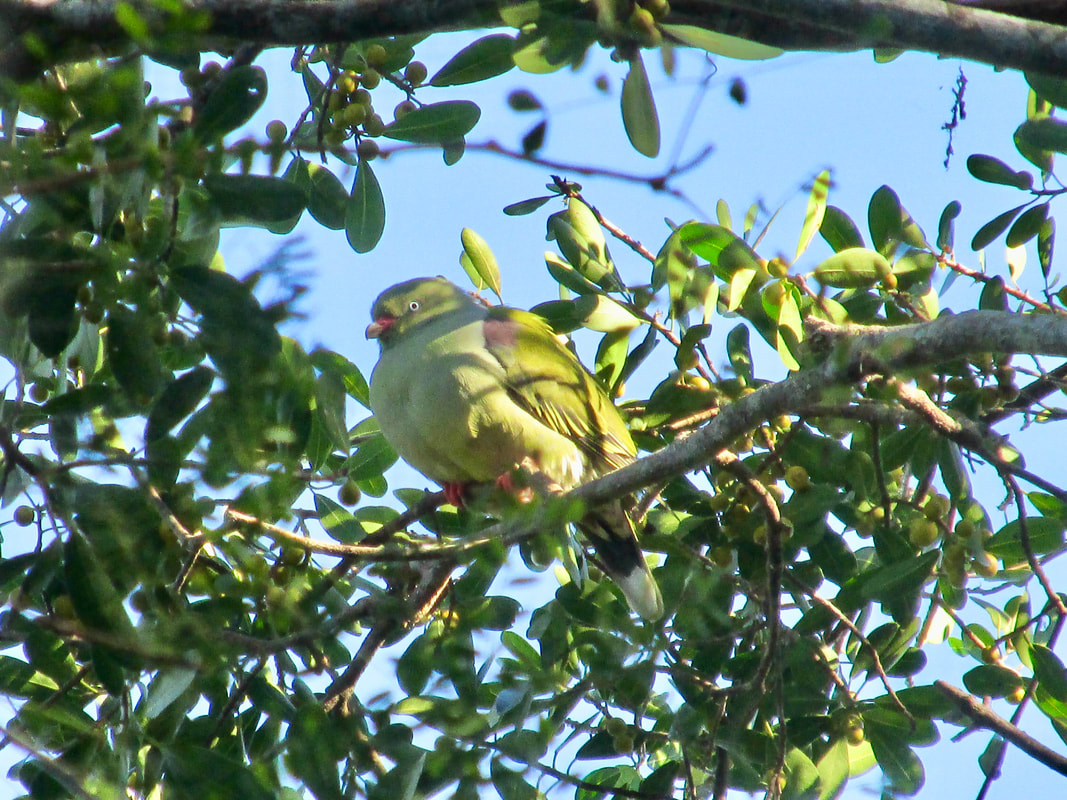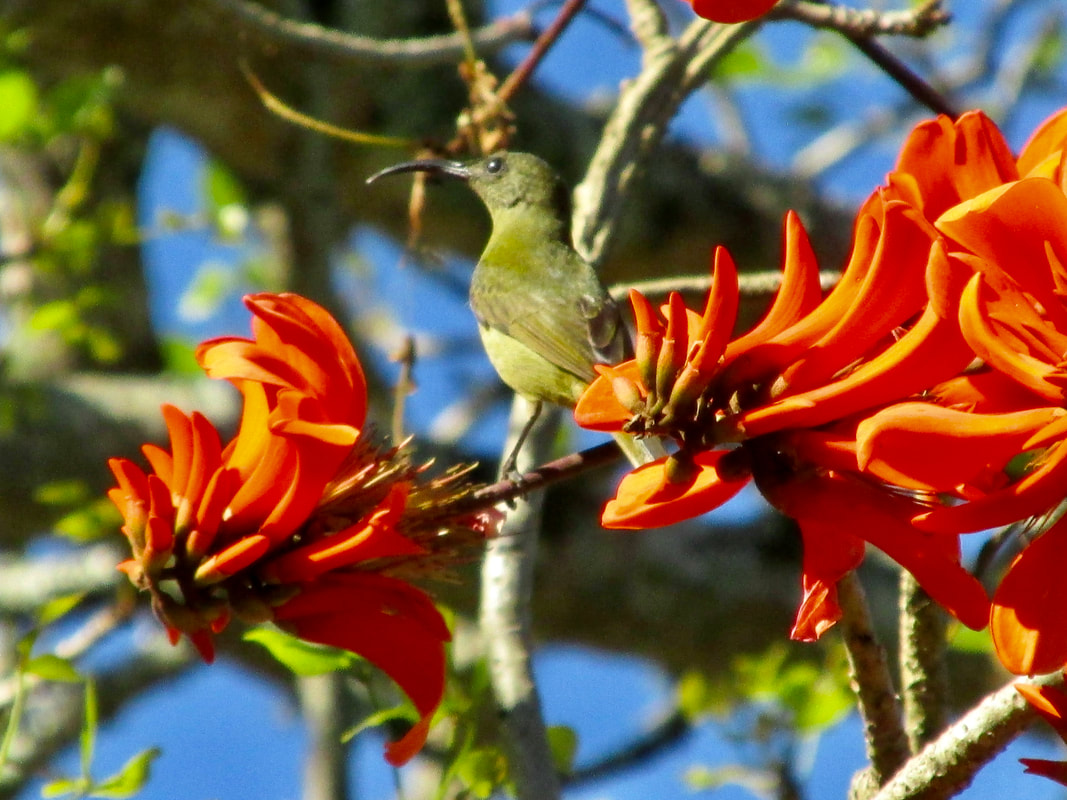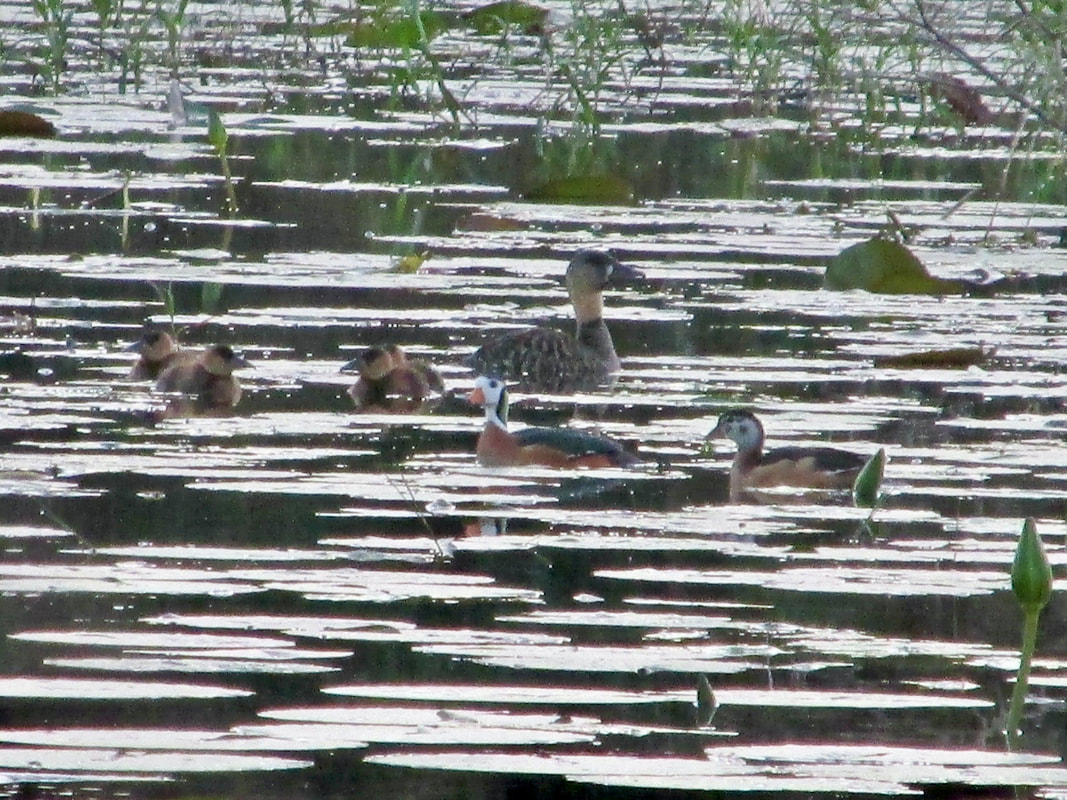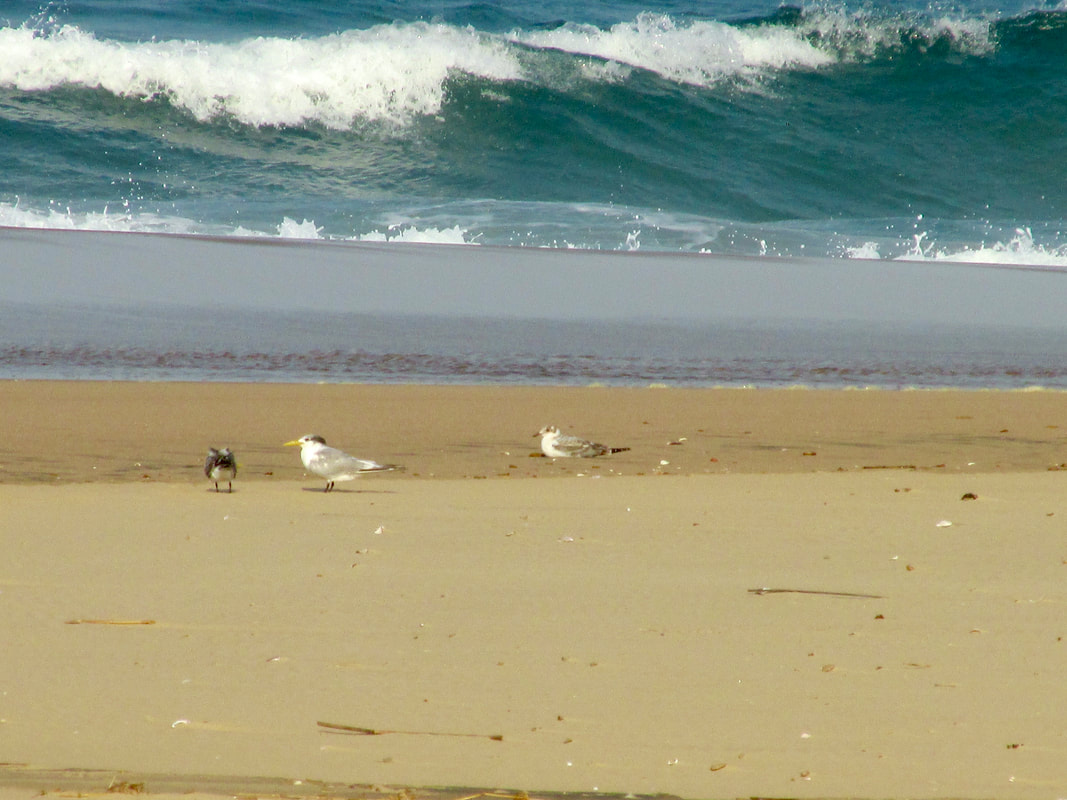|
Birding in St Lucia has been splendid this month with many surprises! The Lake St Lucia estuary mouth has been on fire! The discovery of a Saunders's tern in the early part of the month caused a huge stir amongst birders countrywide with many people making the journey to see the tiny tern- a first ever record for South Africa! The furthest South they usually make it is Central Mozambique so this individual was relatively far out of range.Unfortunately it has not been seen for the last 5 days so may have left us now. Another surprise was the discovery of 2 Damara tern (in full breeding plumage) at the tern roost on the 12th September. Unfortunately the Damara terns only spent one day at the roost before moving on. These small terns breed on the Southern Cape and up the Namibian Coast and usually overwinter on the West African coast but small numbers were recently discovered to also overwinter off the coast in Central Mozambique. The 2 birds seen off St Lucia were possibly in transit to their breeding grounds on the Southern Cape from Mozambique. Complimenting the 2 tern rarities was a group of 3 Red knot (also considered a rarity in KZN). These have been seen regularly but erratically throughout the month. Quite outrageously there were up to 14 Bar-tailed godwit at times at the mouth (also a usually uncommon bird) with a few individuals still present towards the end of the month. Other birds seen at the Lake St Lucia estuary mouth over the course of the month included Terek sandpiper, Grey plover, Eurasian whimbrel, Sanderling, Curlew sandpiper, Little stint, Marsh sandpiper, Common ringed plover, White-fronted plover, Common greenshank, Pied avocet, Ruddy turnstone, African Black oystercatcher, Greater crested, Common, Sandwich and Caspian tern, Kelp gull, Grey-headed gull, African fish-eagle, Goliath heron, Cape cormorant to name a few. In the narrows section of the estuary, Mangrove kingfisher persisted during the early stages of the month but seem to have now all departed for their breeding grounds in the Eastern Cape. The reedbeds are abuzz with Southern brown-throated, Eastern golden, Thick-billed and Lesser masked weaver all busily weaving their nests. We also enjoyed one sighting of African finfoot during the month. In the forest, the action has been happening around the White stinkwood trees which are teeming with the larvae of Celtis leaf beetles at the moment. This feast is attracting plenty of African emerald and Klaas' cuckoos, Green malkoha, Black cuckooshrikes and other insectivorous birds. Fruiting Wild plum (Herpephyllum caffrum) are attracting both Livingstone's turaco and Purple-crested turaco and fruiting figs are attracting Trumpeter hornbill, Crowned hornbill, Yellow-bellied & Sombre greenbul, African green pigeon, Black-bellied starling, Yellow-rumped tinkerbird and White-eared barbet to name a few. The call of Narina trogon males is a common sound in the forest at the moment and the eery foghorn call of the Buff-spotted flufftails can now be heard at dawn, dusk, night and misty/drizzly mornings. A nice surprise in the forest this month was a juvenile Palm-nut vulture! Wetland birding has also not disappointed with plenty of African pygmy-goose and White-backed duck around as well as the odd Lesser moorhen. The Rufous-bellied heron on pan loop (Eastern shores) have been very consistent this month with as many as 5 seen at once! Collared pratincole are also still common at wetland edges. Raptor-viewing has been great throughout the month with sightings of African crowned and Martial eagle, Southern-banded, Brown & Black-chested snake-eagle, African cuckoo-hawk, African Marsh-harrier, Black-shouldered & Yellow-billed kite, Black sparrowhawk and African goshawk.
0 Comments
There was much excitement the last couple of days with the discovery of a Saunders’s tern at the St Lucia estuary mouth tern roost. What makes the discovery so exciting is this is the first ever record of this bird in South Africa. Saunders’s terns breed from the Arabian peninsula to Somalia. In non- breeding season however,birds migrate to the coastline of Tanzania and Madagascar. There was much excitement in 2019 when small numbers of birds were found to be regular at the San Sebastián peninsula in Mozambique. This is by far the furthest South they have been seen on the coastline. For those not familiar with the diagnostic features of the Saunders’s tern: It is a tiny tern in the same size category of Little tern and Damara tern. It is most similar to the Little tern in appearance with the following features being the main difference in non-breeding birds such as the individual found at St Lucia: Saunders’s tern has a more extensive white crown than the Non-breeding Little tern giving it a somewhat masked look. Saunders’s tern have paler upper parts than Little tern In flight, the Saunders’s tern shows more extensive black in upper primaries than little tern and a larger white area on the rear of wing compared to a narrow white trailing edge in the Little tern. Because of its close resemblance to the Little tern the Saunders’s may have ‘gone under the radar’ thus far and might be a more regular visitor than we think. Only time will tell…
There has been a proper feeling of Spring in the forest in the latter half of the month with many of the birds more vocal and busy in preparation for the breeding season. The male Narina trogons started calling midway through the month and we were lucky to observe their floating leks on a couple of occasions. Much of the action in the forest has been centred around fruiting fig trees, flowering Coral trees and the White stink woods which are pushing out new leaves and blossoms. The fruiting figs are attracting large groups of Trumpeter hornbill, African green pigeon, plenty White-eared barbets & Black-bellied starlings, Yellow-bellied & Sombre greenbul, Livingstone’s & Purple crested turaco and Yellow-rumped tinkerbird to name a few. Flowering coral trees are attracting Grey, Purple-banded, Olive & Collared sunbird and Eastern golden weaver. The White stinkwoods-and the insects and caterpillars attracted to their new shoots and blossoms- are attracting Klaas’ & African emerald cuckoo, Olive bush-shrike, Black cuckooshrike, Green malkoha and Rudd’s & Yelowbreasted apalis. Birding in the forest is always great at this time of year with increased bird activity, more light entering the forest with the sparse foliage and the fact that winter-visitors such as Spotted ground thrush, White-starred robin and Chorister robin-chat are still lingering. Other sightings in the forest during the month have included Buff-spotted flufftail, Blue-mantled crested flycatcher, Black-throated wattle-eye, Green twinspot, Grey waxbill, Brown scrub-robin, Square-tailed drongo, Dark-backed weaver to name a few. In the wetlands, as many as 4 Rufous-bellied heron are still regular on the Pan loop, Eastern shores, Isimangaliso. African pygmy-goose and White-backed duck remain pleasantly common. Other common waterfowl on the wetlands include White-faced whistling duck, Yellow-billed duck, Red-billed teal, Spurwinged goose, African spoonbill, African jacana, Striated heron, Intermediate egret, Black crake, Black-headed and Grey heron. A highlight during the month was a sighting of Allen’s gallinule. Wetland edges are producing an ever-increasing number of Collared pratincole as well as Pale-crowned, Rufous-winged & Croaking cisticola and Yellow-throated longclaw. Saddle-billed stork have also been a common sight over the month. Sections of the Eastern shores were burnt during the month and newly burnt areas (easier to spot prey)have been attracting a variety of raptors such as Brown, Black-chested and Southern-banded snake eagle, Bataleur, Martial eagle as well as scavenging birds such as Wooly-necked stork and Yellow-billed kite directly after the burn.
Lastly, the tern roost at the estuary has held Greater crested, Caspian, Little and Common tern. Other birds regular at the mouth and surrounding beaches have been African Black oystercatcher, Grey-headed gull, Cape gannet, Goliath heron, Western Osprey, African fish-eagle and Palm-nut vulture. Flocks of Lesser and Greater flamingo have also been around the estuary mouth in recent weeks. In the estuary narrows section we continued to enjoy regular sightings of Mangrove kingfisher during the month.  African cuckoo-hawk African cuckoo-hawk It was another great birding month in St Lucia with plenty fantastic sightings. The estuary mouth has curved Northwards and as a result a sand spit has developed on the ocean side of the channel. The tern roost (consisting of Greater crested, Little, Caspian and Common tern) can usually be found at the spit.Other birds regularly seen at the mouth include African black oystercatcher, Western Osprey, Cape cormorant, African fish-eagle, Eurasian whimbrel, White-fronted plover, Goliath heron, White-faced whistling duck, Sanderling, Common sandpiper and Kittlitz’s plover. Amazingly a Crab plover was present at the mouth earlier in the month but did not hang around for long (only a couple of days). At the estuary edges, we have continued to enjoy regular sightings of the beautiful Mangrove kingfisher during July, particularly in areas with high concentrations of crabs. The wetlands have also produced good birding with at least 3 Rufous-bellied heron regular in the wetlands on pan loop (Isimangaliso Wetlands Park)during the course of July and African pygmy-goose, White-backed duck and Lesser moorhen also still pleasantly common throughout the month. Other highlights included sightings of Rosy-throated longclaw and Lesser jacana. Collared pratincole returned in the latter stages of the month and their numbers continue to grow. They can be seen at wetland edges and are often even found perched in the road within the Isimangaliso Wetlands Park. The African crake at Main beach, St Lucia was seen erratically in the early stages of the month but has since proven rather elusive. Raptor-viewing has been fantastic with regular sightings of Brown, Black-chested and Southern-banded snake-eagle, Martial eagle, African cuckoo-hawk, African harrier-hawk, African marsh harrier, African fish-eagle and Crowned eagle. The Crowned eagle have been seen calling regularly at their 2 nesting sights during the course of July. In the forest we have enjoyed great sightings of Green malkoha, Buff-spotted flufftail, Woodward’s batis, Rudd’s apalis, Olive bush-shrike, Blue-mantled crested flycatcher, Spotted ground-thrush, Livingstone’s turaco, Brown scrub-robin, Chorister robin-chat, Black-throated wattle-eye and a special sighting of African broadbill. Flowering Cape honeysuckle and Coral trees are attracting a nice variety of sunbirds including Collared, Purple-banded, Grey, Olive and Scarlet-chested. Lastly, we enjoyed good sightings of Fiery-necked and Swamp nightjar during the course of July.  African crake, St Lucia African crake, St Lucia Wetlands birding has been fantastic again this month. Many of the wetlands have receded and areas of flooded grassland have dried up due to a relatively dry month and this seems to have concentrated the birds into the main wetlands and pans again. African pygmy-goose, White-backed duck, Squacco heron, Saddle-billed stork, Red-billed teal, White-faced whistling duck, Intermediate egret, Little grebe, Black crake, Reed cormorant and African jacana are regular on many of the wetlands. A few wetland rarities seen during the month include Lesser moorhen, African crake and Rufous-bellied heron. The African crake(s) in particular were a big surprise. At least 3 individuals were observed in the wetlands close to St Lucia. The Rufous-bellied herons (also at least 3 individuals) which have not been seen for a long while were once again present at their favourite spot (the wetlands on pan loop, Eastern shores). It’s been busy in the forest with fantastic sightings of many of the winter-visiting birds such as Spotted ground-thrush, White-starred robin, Chorister robin-chat during the month. An unusual record for the area in the forest this month was a Yellow-throated woodland warbler on the Igwalagwala trail. The forest residents also came to the party with nice sightings of Narina trogon, Green malkoha, Woodward’s batis, Rudd’s apalis, Livingstone’s turaco, Eastern nicator, Brown scrub-robin, Blue-mantled crested flycatcher, Grey waxbill, Scaly-throated honeyguide, Olive bush-shrike and Buff-spotted flufftail during the month. Quite outrageously, we managed to see 5 different Buff-spotted flufftail individuals on a single morning walk this month! There has been a large tern roost at the estuary mouth this month consistently predominantly of Caspian and Greater crested tern. Other birds regularly seen include Western osprey, Kelp gull, African black oystercatcher, Sanderling, Yellow-billed stork, Eurasian whimbrel and out at sea- Winter-visiting Cape Gannet and Cape cormorant. In the narrows section of the estuary we have enjoyed regularly sightings of African finfoot during the month and Mangrove kingfisher have been seen regularly at the estuary edges Nocturnal birding has been great with sightings of African wood-owl, Swamp nightjar, Fiery-necked nightjar, Spotted eagle-owl and White-backed night-heron
 Mangrove kingfisher, St Lucia. Mangrove kingfisher, St Lucia. It was a great birding month in May. The forest birding has been superb with all of the winter-visiting altitudinal migrants now present. We have enjoyed regular sightings of Spotted ground-thrush, White-starred robin, Chorister robin-chat, Olive bush-shrike, Grey cuckooshrike and even a Yellow-throated woodland-warbler (a very unusual record for the area). Will be interesting to see if any Eastern Bronze-naped pigeon turn up again this Winter after 3 reported sightings last winter. The cooler Autumn & Winter months are always wonderful for birding in the forest because many of the usually secretive and skulking forest birds can be found sunning themselves on an exposed perch. The foliage of the trees is also less rank making visibility better. We have enjoyed great sightings of Livingstone’s turaco, Green malkoha, Woodward’s batis, Rudd’s apalis, Black-throated wattle-eye, Brown scrub-robin, Grey waxbill, Eastern nicator, Red-fronted tinkerbird, Gorgeous bush-shrike and Green twinspot. Black-bellied starling and Thick-billed weaver are moving in their large, noisy winter flocks again which are often the centre of a bird party- other birds capitalising on the disturbance caused by the large flocks and resulting flushed insects. Buff-spotted flufftail have been nice and consistent in the latter half of the month. Processionary moth caterpillars are abundant at the moment, attracting overwintering Klaas’ and African emerald cuckoo, Black cuckooshrike, Grey cuckooshrike and Green malkoha. Things have quietened down at the estuary mouth recently with many of the summer-visiting waders and terns now absent but still regular sightings of Western Osprey, Palm-nut vulture, Eurasian whimbrel, African black oystercatcher, Goliath heron, Sanderling, Caspian tern and Greater crested tern make it a very worthwhile walk. The winter-visiting Mangrove kingfisher are back and we have enjoyed consistent sightings of this beautiful bird during the latter part of the month. The wetlands are still full to the brim after another 200mm of rain fell in the space of a day earlier in the month! Wetlands close to St Lucia are still holding Lesser moorhen, African pygmy goose, White-backed duck, Intermediate egret amongst other water birds. In the grasslands and Umdoni savanna of the Eastern shores, Senegal Lapwing are regular in short grassy areas and winter-visiting Pale-crowned cisticola can once again be seen at wetland edge. Nocturnal birds seen during the month include Swamp nightjar, Fiery-necked nightjar and African wood-owl.  Green malkoha are often members of mixed species bird parties in St Lucia Green malkoha are often members of mixed species bird parties in St Lucia Birding in the forests around St Lucia is usually characterised by long periods of relative quiet which are interrupted suddenly by periods of absolute chaos where birds of different species are calling and flitting seemingly everywhere and in all strata of the forest-from the forest floor to the canopy. These congregations or loose affiliations of birds are commonly referred to as ‘bird parties’. Typically, bird parties consist predominantly of insectivores but this is not a rule and often depends on the catalyst for the bird party. As an example, a fruiting fig tree may attract a variety of frugivorous birds such as White-eared barbet, Livingstone’s turaco, Trumpeter hornbill, African Green pigeon, Purple-crested turaco, Yellow-rumped tinkerbird and Blackbellied starling. The fruits may also attract a variety of insects. As the frugivorous birds move through the trees feeding, they flush these insects making them more visible and easy to catch for insectivorous birds such as Green malkoha, Square-tailed drongo, Narina trogon and Olive bush-shrike. Whilst feeding the frugivorous birds also drop fruits to the ground. Decaying fruits attract detrivores which provide food for birds of the forest floor such as Terrestrial brownbul, Brown scrub-robin and Red-capped robin-chat. Fruit flies attracted to the decaying fruits also provide food for insectivores in the lower to mid-stratum such as Blue-mantled crested flycatcher, Woodward’s batis, Black-throated wattle-eye and Green-backed camaroptera. The catalyst for bird parties may also differ. It could be an eruption of caterpillars, termite emergences or nectar-filled flowers. Besides the food aspect, birds also benefit from bird parties in other ways. With plenty of birds around there is increased vigilance for avian predators such as African goshawk, Little sparrowhawk and Black sparrowhawk as well as for snakes. Participants in the bird party also have the ability to group together and mob predators when in groups whereas individually they are powerless. Lastly, there is also the benefit of ‘having more on the menu’ for predators. The predators have more options when hunting and therefore birds are safer on an individual level. Some bird species may therefore join bird parties purely from a safety perspective even if it doesn’t benefit their feeding. This is often the case with seed eaters such as Grey waxbill, Green twinspot and Red-backed mannikin. Bird parties do not however always start due to a rich food source. According to my observations around St Lucia, Terrestrial brownbul are the common denominator in most bird parties. They are gregarious and travel in noisy groups along the forest floor. Their Afrikaans name ‘boskrapper’ (bush scratcher) describes them best. They scratch very enthusiastically through leaf litter, tossing leaves to the side as they search for invertebrate prey. The disturbance they cause flushes insects for other insectivorous birds. As a result, a group of Terrestrial brownbul usually has a Green-backed camaroptera in tow as well as other lower to mid-stratum insectivores. In short, the bird party starts from the forest floor upwards in this example- the disturbance caused by birds in each strata of the forest benefitting those above. Needless to say, these chaotic bird parties have most birders wishing they had independently moving eyes like chameleons, rotating heads like owls and neck muscles that didn’t hurt so damn much from gazing upwards!  Livingstone's turaco, St Lucia Livingstone's turaco, St Lucia April is the month in St Lucia where the big 'shift change' happens. All of our summer visitors have finally left whereas the first of our winter migrants have started to show. In the forest we have started to see Spotted ground thrush, White-starred robin, Olive bush-shrike and Dusky flycatcher whilst in the grasslands Jackal buzzard, Fiscal flycatcher and Common stonechat are regular sights. Eagerly awaiting the arrival of the rest of our winter visitors such as Mangrove kingfisher, Chorister robin-chat, Grey cuckooshrike, Bronze-naped pigeon etc. The wetlands in the Eastern shores section of the Isimangaliso Wetlands Park are teeming with Lesser moorhen at the moment. It has been interesting to observe them lingering around a decaying hippo carcass- feasting on the maggots. Birds seen in the wetlands and wetland edge close to St Lucia include White-backed duck, African pygmy goose, Spurwinged goose, Intermediate egret, Striated heron, Red-chested flufftail, Red-billed teal, White-faced whistling duck, Little grebe, Great white egret, Rufous-winged cisticola, Yellow-throated longclaw, Croaking cisticola, Brimstone canary, Black-headed heron and Malachite kingfisher. The estuary mouth is holding good numbers of Lesser crested tern at the moment as well as Greater crested, Sandwich, Common, Little and Caspian tern. The Palm-nut vulture has been seen more sporadically (probably due to less rainfall and a weaker outflow into the ocean- meaning less fish). The mouth has also produced Goliath heron, Greater flamingo, Western Osprey, African black oystercatcher, Yellowbilled stork, Sanderling, Kelp gull, Eurasian whimbrel. Unfortunately the 3 African skimmer have not been seen at the estuary mouth since the middle of the month. Birding in the forest has been great with nice sightings of Green malkoha, Woodward’s batis, Blue-mantled crested flycatcher, Rudd’s apalis, Buff-spotted flufftail, Narina trogon, Green twinspot, Livingstone’s turaco, Black-throated wattle-eye, Black cuckooshrike, Black saw-wing, Ashy flycatcher, Olive bush-shrike, White-starred robin. On one memorable morning I observed 3 seperate Buff-spotted flufftail cross the trail path! Raptor-viewing in the Isimangaliso Wetlands Park has been fantastic as always with Black sparrowhawk, African goshawk, Southern banded snake eagle, martial eagle, Jackal buzzard, African harrier hawk, Crowned eagle, African fish eagle, long crested eagle, Secretary bird. Also of interest, African finfoot have been seen quite regularly on estuary boat cruises this month.  The Eastern shores, Isimangaliso Wetlands Park during a wet period: A mosaic of Wetlands with Lake St Lucia in the far distance. The Eastern shores, Isimangaliso Wetlands Park during a wet period: A mosaic of Wetlands with Lake St Lucia in the far distance. Like the rest of Southern Africa, St Lucia typically alternates between prolonged dry spells and wet spells according to the El Niño and La Niña weather phenomenons. These opposite extremes, drastically change the face of the landscape with resulting changes in birdlife. The most recent El Niño episodes occurred from 2014 until 2016 and again in 2018/19. The associated drought which reached its peak in 2016 was one of the worst in recorded history. The wetlands had mostly disappeared with a couple of exceptions, and even these were shallow and small in size. As a result wetlands waterfowl were few and far between. Lake St Lucia dried up to the extent that it was possible to walk right across the lake in some places. A walk on the dried lake bed in places such as False bay revealed thousands of sun-parched fish carcasses. Remaining fish were concentrated into the last remaining deeper pools in the lake which made easy-pickings for the vast flocks of Pelican (both Great white and Pink-backed) which came to take advantage of the easy food source. Large flocks of these birds could be seen soaring above the lake most days. Also during this time almost every tall conifer tree in St Lucia was a hotly contested perch for Pink-backed pelican to sleep on overnight. It was interesting to watch them jostling for position at dusk every evening, dive-bombing each other kamikaze-style to knock their contester off his/her perch. In the time period when the lake was shrinking, vast shallow areas attracted large flocks of both Greater & Lesser flamingo which could be seen as vast whitish/pink swathes on the edges of the lake. Apart from the birds, the dry lake and wetlands also had a major impact on the local hippo population. Competition for remaining water was severe and many battle-scarred and wounded hippo could be seen. Many (especially young sub-adult bulls) took refuge in the forest during the day as an alternative to water to try keep cool whilst staying out of the way of dominant bulls. It was a risky time in St Lucia as a result with some hippos sleeping in gardens and lodge grounds during this time. In 2017, Southern Africa enjoyed a years respite from the grips of El Niño with Zululand experiencing a wetter year than other parts of the country. All of a sudden the St Lucia area had large influxes of African cuckoo-finch and Harlequin quail and even the odd Black coucal (all unusual birds for the area). In the Mkhuze section of the Isimangaliso Wetlands Park, huge flocks of Red-billed quelea (attracted by good seeding grass) could be seen flying in their amazing murmurations. In certain areas of Mkhuze, every acacia tree/sickle bush was coated with dozens of nests. The thousands of nesting quealeas in turn attracted large congregations of Lesser spotted eagle (another uncommon bird for the area) with groups of over 50 birds seen in areas with quealea nests. As often happens in wetter years after prolonged drought, the area also experienced insect ‘plagues’. The first was seen in the nearby Hluhluwe/Umfolozi game reserve in 2017 where a plague of army worms marched across the landscape, devouring almost every leaf off every Tamboti tree in their path. Meanwhile, in St Lucia in 2021 a plague of Celtis leaf beetle did the same to all the White stinkwood trees, devouring almost every leaf off every White stinkwood in the forests. These edible larvae formed dense clusters on the trunks of trees, buildings and surrounding areas before pupating into the beetles themselves. Needless to say, this rich food source attracted many insectivorous birds to the area. African emerald cuckoo, usually uncommon in St Lucia, were seemingly everywhere. Birding surrounding the White stinkwoods was absolutely amazing and usually secretive birds such as Green malkoha just sat out in the open, seemingly too engorged to care. With the drought ending and Southern Africa entering a strong La Niña episode in 2020 (with associated high rainfall) the Lake St Lucia estuary mouth has breached twice in recent years (the first artificially to alleviate flooding upstream and the second naturally) . The initial few weeks after the breaches- effectively like a plug being pulled on the lake system- were an absolute amazing wildlife spectacle to witness. The rush of water out of the mouth into the ocean pulled thousands upon thousands of freshwater fish, an assortment of snakes and even crocodiles onto the surrounding beaches. This fish feast attracted a big variety of piscivorous birds and scavenging birds to the area. The beaches either side of the estuary mouth were literally packed with an unusually high quantity of terns. At the estuary mouth itself, multiple Bull sharks could be seen hunting at any one time- in amongst big crocs! The crocs lay facing into the outgoing current, snapping up any fish that swam into their open jaws. Quite outrageously, someone even photographed a croc devouring a baby bull shark caught in this way! With the estuary mouth open and freshwater fish washing up on the beaches most low tides, Palmnut vulture have become a regular sight on the beaches adjacent to the mouth in recent years- scavenging on the washed up fish carcasses. The open estuary mouth has also turned up some interesting rare vagrants in recent years such as Crab plover and African skimmer. The rains arrived properly in 2021/2022 with 2022 being the wettest year recorded since 1953- a whopping 2000mm of rainfall recorded in St Lucia! As a result of the high rainfall, the wetlands within the Isimangaliso Wetlands Park have returned and so have the waterfowl. Birds such as African pygmy-goose, White-backed duck, Lesser moorhen, Dwarf bittern and a bevy of other more common waterfowl have returned to the area. Birds such as Rosy-throated longclaw too are more common now that the Wetlands have returned. Lake St Lucia has also filled to the brim. Latest predictions predict that we may enter another El Niño period later this year. Will be interesting to see what effects this will have on the area and the birds again!  Lesser noddy at Cape Vidal Lesser noddy at Cape Vidal It has been another wet month in St Lucia with an outrageous 230mm falling in the space of a day on the 12th March! This has kept the grasslands flooded and the wetlands topped up. Lesser moorhen are pleasantly common in the flooded grassland whilst African pygmy-goose and White-backed duck are nomadic between the different waterlily-covered wetland patches. Many of the wetlands and flooded grassland are bordering (and in many cases overlapping onto) the road on the Eastern shores at the moment offering splendid close up views of wetland waterfowl such as Squacco heron, Intermediate egret, Red-billed teal, African jacana, Wood sandpiper, White-faced whistling duck, Black-headed & Purple heron, African pied, Malachite and Giant kingfisher to name a few. The big news of the month was the discovery of the Lesser noddy at Cape Vidal. This endearing and very confiding bird has treated many birders to fantastic views and photographic opportunities- a real rare privilege. Unfortunately, the bird has subsequently disappeared. At the St Lucia estuary mouth the 3 African skimmer still remain and can usually be seen skimming at dawn and dusk. The rest of the day they can usually be found in amongst the sizeable tern roost which regularly holds Greater crested, Lesser crested, Common, Little, Sandwich and Caspian terns. Freshwater fish and prawns continue to wash out of the St Lucia estuary mouth on the low tide and this has become a big draw card for a Palm-nut vulture which has been a regular sight on the estuary beaches this month. Western Osprey has also been regular at the mouth recently and can often be seen hunting out at sea. Other birds seen at the mouth and surrounding beaches over the course of the month include African black oystercatcher, Eurasian whimbrel, Kittlitz’s plover, Grey plover, Common sandpiper, Sanderling, White-fronted plover, Blue-cheeked bee-eater, Brimstone canary, Sand Martin, Kelp gull and African fish-eagle. Late summer is always more challenging in the forest with vegetation at its most rank and many birds quietening down and becoming less active. Regardless of this we have still enjoyed some fantastic sightings of Narina trogon, Green malkoha, Green twinspot, Brown scrub-robin, Black-throated wattle-eye, Bluemantled-crested flycatcher, Livingstone’s turaco, Woodward’s batis, Tambourine dove, Buff-spotted flufftail, Rudd’s apalis during the month. A lot of the action in the forest has still been centred around fruiting fig and tassleberry trees. In the grasslands, the first signs of winter have come with the arrival of the odd Stonechat (winter visitors to the area) and even a Jackal buzzard (an uncommon altitudinal winter migrant). The Blue-cheeked bee-eater and Barn swallow have also started to gather in large numbers preparing for their long migration to the North. Some interesting behavioural observations this month: We observed Grey waxbill using the abandoned nest of Dark-backed weaver as their own. The second time I have observed this behaviour around St Lucia. We discovered another Collared sunbird nest perfectly positioned in close proximity to a paper wasp nest- an ingenious way to deter predators. The Red-capped robin chats were heard mimicking a large assortment of bird calls including African fish eagle, Fiery-necked nightjar, African emerald cuckoo, Orange-breasted bush-shrike and Blue-cheeked bee-eater and Green malkoha. Another mimicker, the Square-tailed drongo, was up to its usual tricks mimicking African goshawk around a fruiting fig tree, thereby chasing other birds from the area to take full advantage of the fruit fly feast on offer. Lastly, nocturnal birding produced nice sightings of European nightjar and African wood-owl this month with Swamp nightjar proving to be scarce. |

